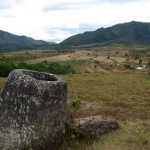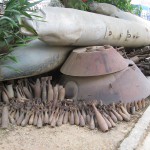
There is one main purpose of visitors to Phonasavanh. It’s the UNESCO World Heritage site of the Plain of Jars. This area is a very wide plateau, part of the high mountain plain here, full of farms growing rice and other crops, breeding ducks for sale, etc. and surrounded by hills and mountains.
People from Southern China, part of a powerful regime that moved in 3000 years ago, placed huge urns made of rock, stucco and other materials onto the plain for mysterious reasons as yet not completely understood. However, the archeological evidence shows jewelry, bones and other ceremonial objects, thus suggesting a funerary purpose of sorts.

There are 60 sites with hundreds and hundreds of these enormous urns, ranging in size up to six feet tall and four feet wide, with walls up to half a foot wide. The local legend, however, is that they were made to brew and store rice wine since smaller jars are used for that purpose by village tribes. To us, though, the now open mouths of the vast urns keen about the rise and fall of civilizations – some cracked with time, some toppled or broken by more recent tribes and conquerors, some split by trees that arose to reclaim nature’s place.

But it is not just ancient history that speaks to you at the Plain here. Amid the burial jars, you can see bomb craters and trenches that remain to this day from the secret Laotian war conducted by the CIA during the more public Vietnam war of the 60s. Just as this plain was a vital one 3000 years ago for controlling the region militarily, it was also true in the 20th century. The Vietnamese tried to move troops and goods through this area and on to South Vietnam, using the trenches for protection; the U.S. wanted to stop them. As a result, today, only three of the 60 sites are open to the public, as they are still dangerous because of all the unexploded bombs dropped by the United States in that time. On display at the local tourism center are hundreds of shell casings for some of these bombs.

It’s a frightening story. In Laos alone, there were 580,000 bombing raids during the war, 1 every 8 minutes for 9 years. By the end, we had dropped 1 ton of bombs for each and every Laotian, whose population numbered only 3 million at the time. Even when it was over, 20,000 people were killed by the unexploded stuff. This doesn’t even count the pollution caused by the exfoliates like napalm we also used. It’s only from the efforts of international clean-up organizations that you could dare visit this area.
And all this bred from paranoia and fear in the mid-century, in this case about communism. So, consider how amazing it is that the Lao people can still welcome Americans to their country, for they prove a gracious and forgiving people. Or perhaps they think of us just as one of the many people – French, Thai, Burmese, Chinese, and other ancient kingdoms – that have laid waste to their land and culture over time at the cross-roads of endless empire building in SE Asia.
The Plain of Jars is full of lessons for us. The urns remind us of our own mortality and our obligation to do well in this world. And it teaches how readily all powers can assert their interests at the peril of those in their way, how the strongest civilizations come and go, and how fear of other cultures can lead us to attacking them with too little reason or humanity.
(For more pictures from Laos, click here to view a slideshow on the itinerary page.)


Unexploded bombs picture is worth a 1000 words…Thanks for this post.